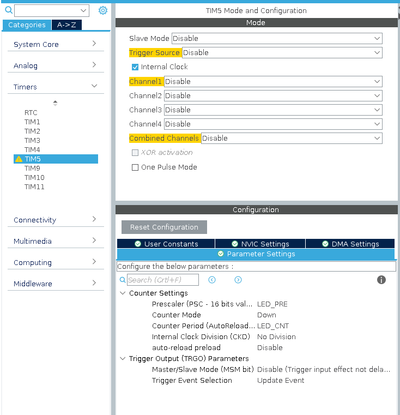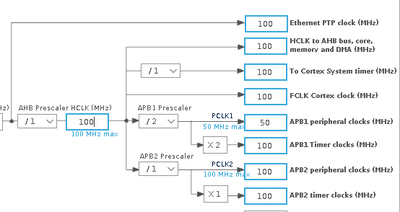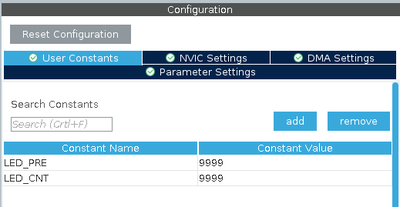Difference between revisions of "STM32 LED Pulse"
Jump to navigation
Jump to search
| Line 19: | Line 19: | ||
It should be equally obvious why this is a really piss poor idea. The function will block for half a second, leaving the processor unable to do anything else for that period. | It should be equally obvious why this is a really piss poor idea. The function will block for half a second, leaving the processor unable to do anything else for that period. | ||
| − | A '''much''' better idea. | + | A '''much''' better idea would be to use a timer (of which most [[stm32]] processors have quite a lot) to handle the delay. |
| + | |||
| + | First, let us configure a timer for this use. | ||
| + | |||
| + | [[File:One shot timer.png|400px]] | ||
| + | |||
| + | In this example, the timer clock is 100 MHz. | ||
| + | |||
| + | [[File:Timer clock.png|400px]] | ||
| + | |||
| + | And the User Variables LED_PRE and LED_CNT are configured like this: | ||
| + | |||
| + | [[File:User Constants.png|400px]] | ||
Revision as of 04:15, 23 March 2021
Imagine you had the requirement to turn on a LED for a specific length of time at the press of a button.
Obviously, responding to a button press could be easily handled by an external interrupt, so one could come up with something like:
void HAL_GPIO_EXTI_Callback(uint16_t GPIO_Pin) {
if (GPIO_Pin == BTN_Pin) // If the button
{
HAL_GPIO_WritePin(LED_GPIO_Port, LED_Pin, GPIO_PIN_RESET); // Switch LED ON
HAL_Delay(500); // Wait 500 ms
HAL_GPIO_WritePin(LED_GPIO_Port, LED_Pin, GPIO_PIN_SET); // Switch LED OFF
}
}
It should be equally obvious why this is a really piss poor idea. The function will block for half a second, leaving the processor unable to do anything else for that period.
A much better idea would be to use a timer (of which most stm32 processors have quite a lot) to handle the delay.
First, let us configure a timer for this use.
In this example, the timer clock is 100 MHz.
And the User Variables LED_PRE and LED_CNT are configured like this:


